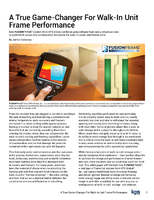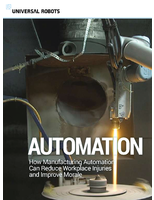Instrument Data Recorder enables simultaneous sampling.
Share:
Press Release Summary:
 DAQ 800 Series integrates field-connectable sensor termination, analog data acquisition, and sigma-delta analog-digital conversion (ADC). Available with 32 channel (DAQ832) or 48 channel (DAQ848) configurations, each channel offers independent 16-bit ADC resolution with programmable gain, and can sample rates at up to 200,000 samples/sec. They support aggregate data rates of up to 6.4 MB/sec, with no external signal conditioning required.
DAQ 800 Series integrates field-connectable sensor termination, analog data acquisition, and sigma-delta analog-digital conversion (ADC). Available with 32 channel (DAQ832) or 48 channel (DAQ848) configurations, each channel offers independent 16-bit ADC resolution with programmable gain, and can sample rates at up to 200,000 samples/sec. They support aggregate data rates of up to 6.4 MB/sec, with no external signal conditioning required.Original Press Release:
Compact, High-Capacity Digital Recorder from KineticSystems Delivers Complete Data Acquisition Solution
(Lockport, Illinois) - KineticSystems Co.'s new DAQ 800 Series integrates field-connectable sensor termination, analog data acquisition and high-performance sigma-delta analog-digital conversion (ADC) into a single high-speed, wide band instrumentation data recorder, available in either 32-channel (DAQ832) or 48-channel (DAQ848) configurations. Each channel features independent 16-bit ADC resolution with programmable gain, and is capable of sampling rates up to 200,000 samples/second. Data is transferred via a noise-resistant fiber optic cable to a host PC running KineticSystems' new easy-to-use DynaDAQ control software to form a complete PC-based data acquisition system. Both the DAQ832 and DAQ848 can support aggregate data rates of up to 6.4 MB/sec. No external signal conditioning is required. The DAQ832 system is listed at under $30,000, while the DAQ848 is priced at under $40,000.
"The DAQ832/848 is an ideal solid-state replacement for bulky analog tape recording devices," noted Steve Krebs, KineticSystems' Engineering Director, citing the typical digital-vs.-analog advantages of high dynamic range, random accessibility to data, high capacity, and high bandwidth. In addition, the media will not degrade over time, and data quality is not affected by duplication. The 15.1-inch high unit has a small footprint of just 21 ½" X 6" and weighs just 25 pounds.
"The system also offers a dramatic improvement in performance, with greatly enhanced speed and accuracy," continued Krebs. "For example, compare the 200,000/second sampling rate to analog systems typically limited to 50 Ksample range."
The self-cooled DAQ832/848 is suitable for either rack-mounted or tabletop use. Typical applications include general-purpose laboratory recording of analog signals from sensors such as accelerometers and thermocouples. Featuring a ruggedized steel enclosure, the instrument is particularly suited to capturing Noise-Vibration-Harshness (NVH) measurements.
To enable simultaneous sampling, each channel features an independent ADC with associated signal conditioning. The ADCs utilize advanced, highly accurate sigma-delta conversion architecture, which provides inherent filtering and synchronous sampling without the need for costly sample/hold amplifiers or sophisticated analog anti-aliasing filters. Unlike competitive recorders whose multiplexing of inputs to a common ADC increases the likelihood of crosstalk, the independent sigma-delta ADCs reduce crosstalk effects to negligible levels.
The DAQ 832/848 also features independently programmable gain per channel. Users may select from 10 voltage input ranges from ± 10 millivolts to ± 10 volts (up to ± 15 volts as an option), enabling the same recorder to handle both high- and low-level signals and ensuring full utilization of the ADCs' dynamic range.
Connections for field wiring of sensors are screw-type terminations located on the front of the unit. BNC requirement can be handled with an optional termination panel. Connections for each channel consist of signal, return and shield terminations. Two ground terminations are also provided for external connection. Screw-type terminal blocks are removable for easy access to the connections. Trifilar wound transformers are optionally available for improved rejection of common-mode coupling, particularly important in applications where high-frequency common-mode voltages could produce offset errors when acquiring low-level signals (for example, with high-frequency stimulus devices as used in ATE). Common-mode rejection of 80db (DC to 50 kHz) is typical. Connection to the host PC for setup, control and data collection is accomplished via a two-cable fiber optic highway, which provides high immunity to noise. Fiber optic connectivity also allows the DAQ832/848 to be located remotely from the host computer - up to two kilometers away - ideal for hazardous applications, such as the testing of rocket engines. The DAQ832/848 package includes KineticSystems' new DynaDAQ control software with intuitive graphic user interface (GUI) screens. Built on the Windows® NT OS and residing on the host computer, DynaDAQ controls data acquisition setup and configuration, automatic end-to-end system calibration, monitoring and data storage. Users will appreciate the software's capability for remote control of data collection, monitoring of data points and ability to modify data collection parameters, including sample rate, number of active channels and gain per channel. The software formats and exports data to analysis programs, such as LabVIEW, MATLAB®, DADiSP(TM) and other programs accepting ASCII file imports. A viewer utility provides post-processing graphing or charting of acquisition results.
For detailed specifications and available options, contact: KineticSystems Co., LLC, 900 N. State Street, Lockport, Illinois 60441, Phone: 1-800-DATA-NOW (328-2669), Worldwide Phone: (815) 838-0005, USA Fax: (815) 838-4424, Int'l Fax: (815) 838-3195, E-mail: mkt-info@kscorp.com or visit their Web site: www.kscorp.com.




